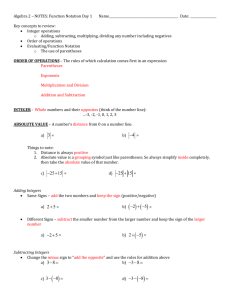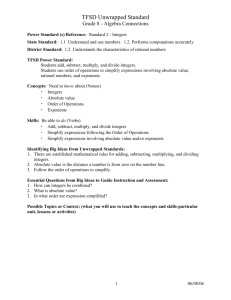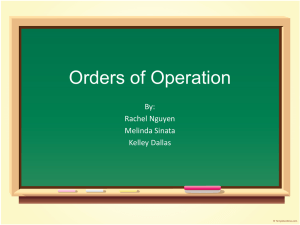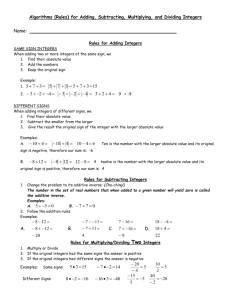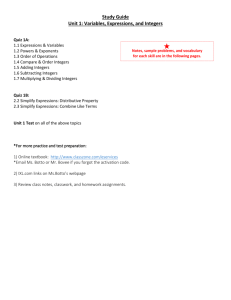Variables, Expressions & Integers Study Guide
advertisement
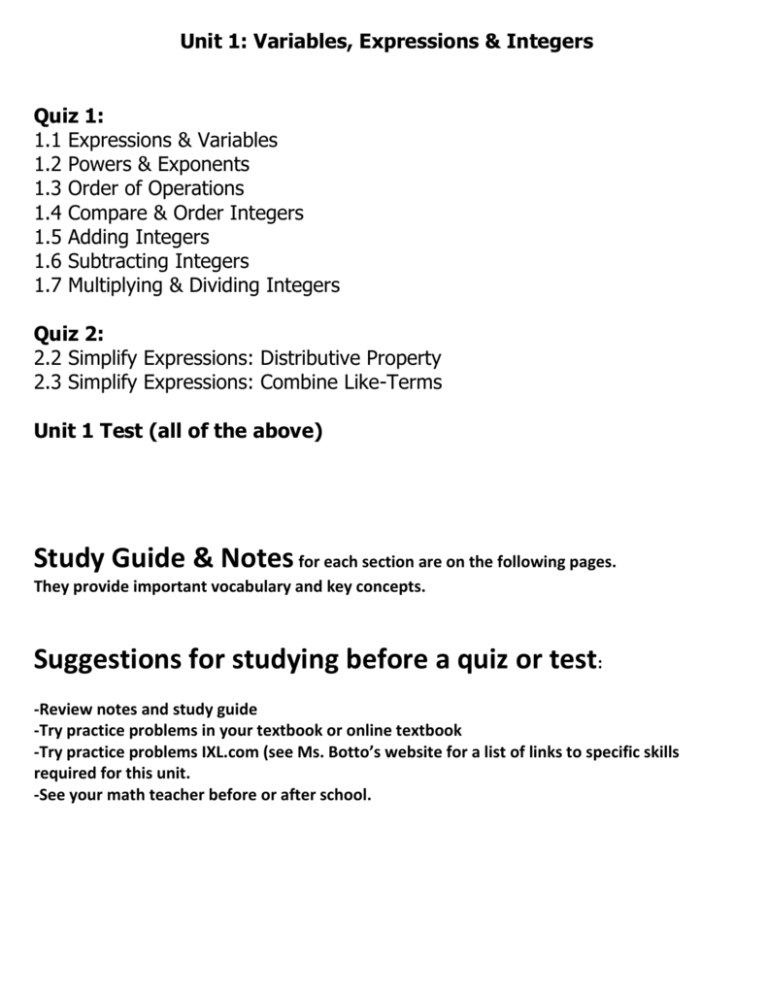
Unit 1: Variables, Expressions & Integers Quiz 1: 1.1 Expressions & Variables 1.2 Powers & Exponents 1.3 Order of Operations 1.4 Compare & Order Integers 1.5 Adding Integers 1.6 Subtracting Integers 1.7 Multiplying & Dividing Integers Quiz 2: 2.2 Simplify Expressions: Distributive Property 2.3 Simplify Expressions: Combine Like-Terms Unit 1 Test (all of the above) Study Guide & Notes for each section are on the following pages. They provide important vocabulary and key concepts. Suggestions for studying before a quiz or test: -Review notes and study guide -Try practice problems in your textbook or online textbook -Try practice problems IXL.com (see Ms. Botto’s website for a list of links to specific skills required for this unit. -See your math teacher before or after school. 1.1 Expressions & Variables Expression: numbers, operations, and sometimes variables. 10 8(2) x–4 5 3x + b *Multiplication *Fractions are also division Equation: numbers, operations, sometimes variables, AND always an equal sign. 8(2) = 16 10 5 x – 4 = 10 =2 3x + b = 15 Variable: a letter to represent one or more numbers. 1.2 Powers & Exponents 53 = 125 Is the same as 5 5 5 = 125 Exponents are used to shorten repeated multiplication of the same number. base: the number that is multiplied exponent: how many times the base is multiplied power: the base AND the exponent (“5 to the 3rd power”) 1.3 Order of Operations 1st Grouping Symbols Parentheses: ( ) Radical: Brackets: [ ] Absolute value: Fraction Line (vinculum): *If there are operations in numerator and/or denominator, solve as a group first, then divide. Example: 8(2)+4 4+1 = 20 5 = 4 2nd Exponents -52 = -25 *If there are no parentheses, do NOT drop the negative! (-52) = 25 *If there are parentheses, multiply the base and its given sign according to the exponent: (-5)(-5) = 25 3rd Multiply OR Divide **whichever comes first! 10 ÷ 5 (4) Division comes before multiplication, so divide FIRST, then multiply: 2(4) = 8 5(7–3)÷2 First do the math in parentheses. You would get: 5 (4) ÷ 2 Multiplication comes before division, so multiply first, then divide: 20 ÷ 2 = 10 𝟐𝟒 𝟑 ●2 Division comes before multiplication, so divide FIRST, then multiply: 8 ● 2 = 16 LAST: Subtract OR Add **whichever comes first! Save the easiest operations for last 8–3+2 12 + 4 – 5 Subtraction comes before addition, so subtract FIRST, then add: 5+2=7 Addition comes before subtraction, so add FIRST, then subtract: 16 – 5 = 11 1.4 Comparing & Ordering Integers Integers: all of the counting numbers, their opposites & zero Absolute Value: a numbers distance from zero -5 = 5 5 =5 Opposites: the same distance from zero, but on the opposite side of the number line. The opposite of -5 is 5. The opposite of 5 is -5. LESS- Left MORE - Right 1.5 – 1.7 Integers: Adding, Subtracting, Multiplying & Dividing Adding Integers Rules “Same signs keep and add…” + Positive + + Positive Add, answer is positive – Negative + – Negative Add, answer is negative “…different signs subtract, take the sign of the higher number, then you’ll be exact.” + Positive + – Negative – Negative + + Positive Subtract, answer takes the sign of the greater absolute value Subtract, answer takes the sign of the greater absolute value Examples: 10 + -5 = 5 Subtract: 10 – 5 = 5 Absolute values are 10 and 5 10 is greater, its sign is positive, so the answer is positive –8 + 3 = -5 Subtract: 8 – 3 = 5 Absolute values are 8 and 3 8 is greater, its sign is negative, so the answer is negative Subtracting Integers Rules 1) Insert an addition operation immediately after the first integer: 5 – 10 becomes: 5 + (– 10) – 8 – 5 becomes: – 8 + (– 5) Subtracting Negatives: Subtracting a negative is the same as adding a positive. Think of it as rearranging the 2 dashes to make a positive sign. (– – becomes + ) 6 – -3 becomes: 6 + 3 -7 – (-4) becomes: -7 + 4 2) Follow the adding integers rule to solve. *Sometimes parentheses are used to make negative signs easier to see. Finding Change in Temperature or Elevation: The word “change” implies subtraction. Subtract the integers. IF it was a drop in temperature or elevation, then the final answer is NEGATIVE. If it was a rise in temperature or elevation, then the final answer is POSITIVE. Multiplying & Dividing Integers Rules -------------------------------------------------------------------------------------------------------------------------If the signs are the same, the product/quotient will be positive + Positive and + Positive Product/Quotient is positive – Negative and – Negative Product/Quotient is positive ---------------------------------------------------------------------------------------------------------------------------If the signs are different, the product/quotient will be negative + Positive – Negative and and – Negative Product/Quotient is negative + Positive Product/Quotient is negative 2.3 Combining Like-Terms To simplify expressions, we can combine like-terms. 4x2 + 2 + 3x2 – 1 + x Terms: parts of an expression; includes constants, variables & coefficients. *In above expression, the terms are: 4x2, 2, 3x2, -1, and x Constants: a number that has no variable *In above expression, the constants are: 2 and -1 Variables: letter that represents an unknown amount. *In above expression, the variables are: x2 and x Coefficients: the number that multiplies a variable. *In above expression, the coefficients are: 4, 3 and 1 (1 because there is “one” x, even if 1 is not written there.) Like-Terms: the terms in an expression that “match”. *In the expression above, the like-terms are: 4x2 and 3x2; 2 and -1 (x does not have another like-term.) To simplify the above expression; combine the like-terms: 4x2 + 3x2 = 7x2 2 + -1 = 1 7x2 + 1 + x 2.2 Distributive Property 2(5x -3) *Multiply the number outside parentheses by ALL TERMS inside the parentheses: 2(5x) and 2(-3) = 10x – 6 (4 + 7y) 3 *The multiplier can be before OR after the parentheses. 3(4) and 3(7y) = 12 + 21y **Write expressions in ORDER, alphabetical, exponent value, followed by constants: Final answer: 21y + 12 **It is NOT a multiplier if there is an operation between the number and parentheses, such as (4 + 7y) + 3 More examples of Writing Expressions in CORRECT ORDER: 5x2 – 2x + 7 3x2 + 8x – 7 y + 2 -(3x + 2) *If there is just a negative outside the parentheses, you can read it as “take the opposite of all terms inside the parentheses”: -3x – 2 *This is the same as multiplying -1 to all terms in the parentheses: -1(3x) and (-1)(2) = -3x -2 -2x(6x + 3) *Multiplying the same variables results in using exponents: -2x(6x) = -12x2 -2x(3) = -6x Answer: -12x2 – 6x **When adding the same variables, use coefficients to show final count: Examples: x + 5x = 6x 3y – 5y = -2y
